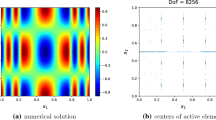Abstract
A parallel, unstructured, high-order discontinuous Galerkin method is developed for the time-dependent Maxwell's equations, using simple monomial polynomials for spatial discretization and a fourth-order Runge–Kutta scheme for time marching. Scattering results for a number of validation cases are computed employing polynomials of up to third order. Accurate solutions are obtained on coarse meshes and grid convergence is achieved, demonstrating the capabilities of the scheme for time-domain electromagnetic wave scattering simulations.
Similar content being viewed by others
REFERENCES
Berenger, J.-P. (1994). A perfectly matched layer for the absorption of electromagnetic waves. J. Comput. Phys. 114(2), 185–200.
Berenger, J.-P. (1996). Three-dimensional perfectly matched layer for the absorption of electromagnetic waves. J. Comput. Phys. 127, 363–379.
Burden, R. L., and Faires, J. D. (1981). Numerical Analysis, Prindle, Weber & Schmidt, Boston, p. 225.
Cockburn, B., and Shu, C.-W. (1989). TVB Runge–Kutta local projection discontinuous Galerkin finite element method for conservation laws II: General framework. Math. Comp. 52(186), 411–435.
Cockburn, B., and Shu, C.-W. (1991). The Runge–Kutta local projection P1-discontinuous-Galerkin method for scalar conservation laws. Math. Model. Numer. Anal. 52, 337.
Cockburn, B., and Shu, C.-W. (1998). The Runge–Kutta discontinuous Galerkin method for conservation laws V: Multidimensional systems. J. Comput. Phys. 141(2), 199–224.
Crispin, J. W., Goodrich, R. F., and Siegel, K. M. (1959). A Theoretical Method for the Calculation of the Radar Cross Sections of Aircraft and Missiles, Technical Report 2591-1-M, University of Michigan.
Grote, M. J., and Keller, J. (1998). Nonreflecting boundary conditions for Maxwell's equations. J. Comput. Phys. 139(2), 327–342.
Hesthaven, J. S., and Warburton, T. (2001). High-Order/Spectral Methods on Unstructured Grids I. Time-Domain Solution of Maxwell's Equations, Technical Report 2001-6, ICASE, NASA Langley Research Center.
Johnson, C., and Pitkaranta, J. (1986). An analysis of the discontinuous Galerkin method for a scalar hyperbolic equation. Math. Comput. 46(173), 1–26.
Kabakian, A. V. (1996). A Spectral Algorithm for Electromagnetic Wave Scattering in the Time Domain—Application to RCS Computation, AIAA Paper 96-2334, 27th AIAA Plasmadynamics and Lasers Conference.
Kabakian, A. V. (1998a). A Spectral Collocation Time-Domain Solver for Maxwell's Equations of Electromagnetics with Application to Radar Cross-Section Computation, Ph.D. thesis, Stanford University.
Kabakian, A. V. (1998b). A Three-Dimensinoal Spectral Collocation Time-Domain Solver for Electromagnetic Wave Scattering, AIAA Paper 98-0980, 36th Aerospace Sciences Meeting & Exhibit.
Kopriva, D. A., Woodruff, S. L., and Hussaini, M. (2000). Discontinuous spectral element approximation of Maxwell's equations. In Cockburn, B., Karniadakis, G., and Shu, C.-W. (eds.), Discontinuous Galerkin Methods: Theory, Computation, and Applications, Lecture Notes in Computational Science and Engineering, Springer-Verlag, New York.
Kopriva, D. A., Woodruff, S. L., and Hussaini, M. Y. (2002). Computation of electromagnetic scattering with a non-conforming discontinuous spectral element method. Int. J. Num Meth. Engin. 53, 105–122.
Petersen, R. (1999). Linux The Complete Reference, 3rd edn., McGraw–Hill.
Peterson, T. E. (1991). Note on the convergence of the discontinuous Galerkin method for a scalar hyperbolic equation. SIAM J. Numer. Anal. 28(1), 133–140.
Reed, W. H., and Hill, T. R. (1973). Triangular mesh methods for neutron transport equation. In Combustion and Flame, AEC Tech. Inf. Cent., pp. 10–31. ANS Top Meet.
Richter, G. R. (1988). An optimal-order error estimate for the discontinuous Galerkin method. Math. Comp. 50(181), 75–88.
Riley, D. J., and Turner, D. (1995). Local Tetrahedron Modeling of Microelectronics Using the Finite-Volume Hybrid-Grid Technique, Technical Report SAND95-2790, Sandia National Laboratories.
Rokhlin, V. (1985). Rapid solution of integral equations of classical potential theory. J. Comput. Phys. 60, 187–207.
Rowell, C. M., Shankar, V. J., Hall, W. F., and Mohammadan, A. (1995). Algorithmic aspects and computing trends in computational electromagnetics using massively parallel architectures. In Proc. IEEE First International Conference on Algorithms and Architectures for Parallel Processing (ICAAAPP).
Ruck, G. T., Barrick, D. E., Stuart, W. D., and Krichbaum, C. K. (1970). Radar Cross Section Handbook, Plenum Press, New York.
Shankar, V., Hall, W. F., and Mohammadian, A. H. (1989a). A CFD-Based Finite-Volume Procedure for Computational Electromagnetics—Interdisciplinary Applications of CFD Methods, AIAA Paper 89-1987.
Shankar, V., Hall, W. F., and Mohammadian, A. H. (1989b). Time-domain differential solver for electromagnetic scattering problems. Proceedings of the IEEE 77(5), 709–721.
Shankar, V., Rowell, C., and Hall, W. F. (1997). Unstructured grid-based parallel solver for time-domain Maxwell's equations. In Proceedings of the 1997 IEEE Antennas and Propagation Society, Vol. 1, pp. 98–100.
Sheen, D. M., Ali, S. M., Abouzahara, M. D., and Kong, J. A. (1990). Application of the three-dimensional finite-difference time-domain method to the analysis of planar microstrip cuircuits. IEEE Trans. Microwave Theory Tech. 38(7), 849–856.
Snir, M., Otto, S., Huss-Lederman, S., Walker, D., and Dongarra, J. (1996). MPI, The Complete Guide, MIT Press, Cambridge, MA.
Taflove, A. (ed.) (1998). Advances in Computational Electrodynamics: the Finite-Difference Time-Domain Method, Artech House, Boston, pp. 253–257.
Warburton, T. (2000). Application of the discontinuous galerkin method to Maxwell's equations using unstructured polymorphic hp-finite elements. In Cockburn, B., Karniadakis, G., and Shu, C.-W. (eds), Discontinuous Galerkin methods: Theory, Computation, and Applications, Lecture Notes in Computational Science and Engineering, Springer-Verlag, New York.
Woo, A. C., Wang, H. T. G., Schuh, M. J., and Sanders, M. L. (1992). Benchmark plate radar targets for the validation of computational electromagnetics programs. IEEE Antennas and Propag.
Woo, A. C., Wang, H. T. G., Schuh, M. J., and Sanders, M. L. (1993). Benchmark radar targets for the validation of computational electromagnetics programs. IEEE Antennas and Propag.
Yang, B., and Hesthaven, J. S. (2000). Multidomain pseudospectral computation of Maxwell's equations in 3-d general curvilinear coordinates. Appl. Numer. Math. 33, 281–289.
Yang, B., Gottlieb, D., and Hesthaven, J. S. (1997). Spectral simulations of electromagnetic wave scattering. J. Comput. Phys. 134(2), 216–230.
Yee, K. S. (1966). Numerical solution of initial boundary value problems involving Maxwell's equations in isotropic media. IEEE Transactions on Antennas and Propagation AP-14, 302–307.
Author information
Authors and Affiliations
Rights and permissions
About this article
Cite this article
Kabakian, A.V., Shankar, V. & Hall, W.F. Unstructured Grid-Based Discontinuous Galerkin Method for Broadband Electromagnetic Simulations. Journal of Scientific Computing 20, 405–431 (2004). https://doi.org/10.1023/B:JOMP.0000025932.17082.18
Issue Date:
DOI: https://doi.org/10.1023/B:JOMP.0000025932.17082.18




